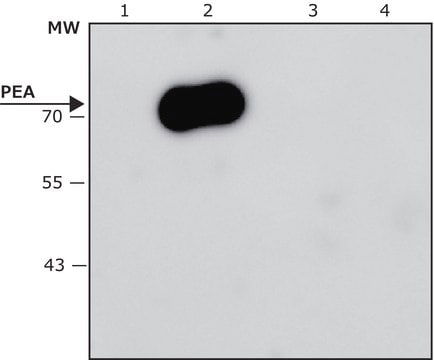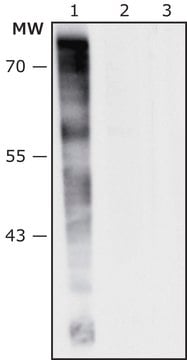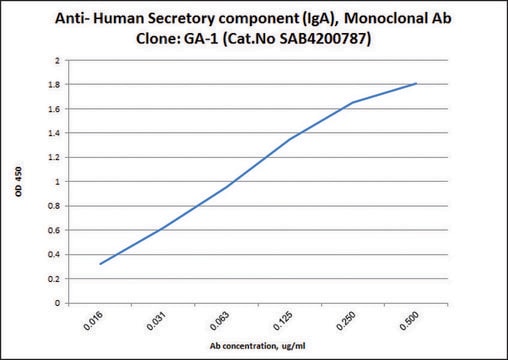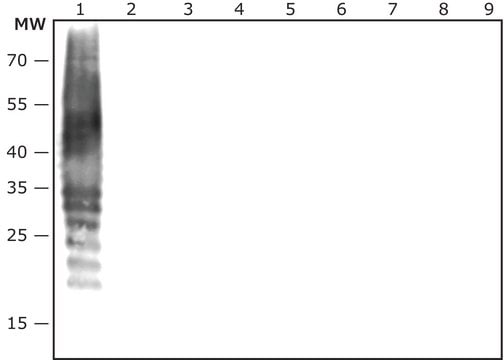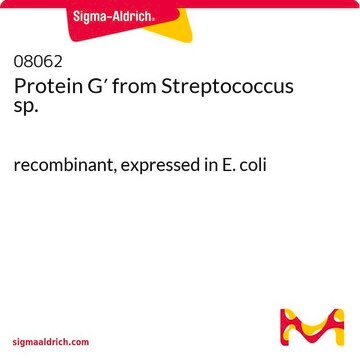推荐产品
一般說明
Enterococcus faecalis is a gram positive, non-motile, facultative anaerobic, coci-shaped bacterium.1,2 It is a commensal bacterium of the human gut and a major opportunistic pathogen in susceptible hosts.1 E. faecalis is the third most common pathogen associated with hospital-acquired infections.2 E. faecalis inhabits the gut in 80% of healthy adultsand is also a part of the oral cavity normal flora in 20% of the adult population. In addition, E. faecalis was also identified in the human urinary tract.1
特異性
Anti-Enterococcus faecalis antibody recognizes E. faecalis lysate and whole dead bacteria
應用
The antibody may be used in various immunochemical techniques including Immunoblotting. Detection of the E. faecalis bands by Immunoblotting is specifically inhibited by the immunogen.
生化/生理作用
E. faecalis contributes to the host in several ways, such as, competing with pathogen bacteria and preventing them from reaching the gut epithelia, prevention of intestinal epithelial barrier leakage and provision of protection from pathogens to the young infant through breast milk consumption.1,3-5
Moreover, E. faecalis also has many effects on the immune system that are beneficial to the host, such as, promoting the secretion of anti-inflammatory cytokines IL-10 and TGF-ß and induction of IgA production.1,6,7
However, when the homeostasis in the gut and mucus barrier is disrupted, especially in susceptible individuals such as in inflammatory bowel diseases (IBD) patients, or upon antibiotic administration, E. faecalis might become an opportunistic pathogen. In such case, the bacteria population overgrows and translocates through the mucus barrier to reach the epithelial cells of the gut where it can enter the bloodstream and the lymphatic system and cause severe inflammation.
Moreover, E. faecalis also has many effects on the immune system that are beneficial to the host, such as, promoting the secretion of anti-inflammatory cytokines IL-10 and TGF-ß and induction of IgA production.1,6,7
However, when the homeostasis in the gut and mucus barrier is disrupted, especially in susceptible individuals such as in inflammatory bowel diseases (IBD) patients, or upon antibiotic administration, E. faecalis might become an opportunistic pathogen. In such case, the bacteria population overgrows and translocates through the mucus barrier to reach the epithelial cells of the gut where it can enter the bloodstream and the lymphatic system and cause severe inflammation.
外觀
Supplied as a solution in 0.01 M phosphate buffered saline pH 7.4, containing 15 mM sodium azide as a preservative.
儲存和穩定性
For continuous use, store at 2-8°C for up to one month. For extended storage, freeze in working aliquots. Repeated freezing and thawing is not recommended. If slight turbidity occurs upon prolonged storage, clarify the solution by centrifugation before use. Working dilution samples should be discarded if not used within 12 hours.
免責聲明
Unless otherwise stated in our catalog our products are intended for research use only and are not to be used for any other purpose, which includes but is not limited to, unauthorized commercial uses, in vitro diagnostic uses, ex vivo or in vivo therapeutic uses or any type of consumption or application to humans or animals.
儲存類別代碼
12 - Non Combustible Liquids
水污染物質分類(WGK)
nwg
閃點(°F)
Not applicable
閃點(°C)
Not applicable
我们的科学家团队拥有各种研究领域经验,包括生命科学、材料科学、化学合成、色谱、分析及许多其他领域.
联系技术服务部门
